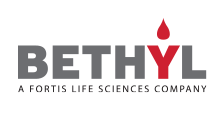Donkey anti-Mouse IgG Heavy and Light Chain Antibody Biotinylated

Product Details
Specifications
Request Formulation Change Phosphate Buffered Saline (PBS) containing 0.2% BSA and 0.05% Pro-Clean 400
Request Formulation Change Phosphate Buffered Saline (PBS) containing 0.09% Sodium Azide
Request Formulation Change Serum containing 0.09% Sodium Azide
Request Formulation Change
Prior to conjugation, immunoglobulin concentration was determined using Beer’s Law where 1mg/mL IgG has an A280 of 1.4. Biotin/antibody protein ratio is 4:1.
By immunoelectrophoresis and ELISA this antibody reacts specifically with mouse IgG and with light chains common to other mouse immunoglobulins. No antibody was detected against non-immunoglobulin serum proteins. This antibody may cross react with IgG from other species.
Biotinylated antibody was demonstrated by reaction with avidin/peroxidase when coated on microtiter wells. Working dilutions should be determined by the investigator. The antibody was isolated by affinity chromatography using antigen coupled to agarose beads and conjugated to horseradish peroxidase (HRP).
Prior to conjugation, immunoglobulin concentration was determined using Beer’s Law where 1mg/mL IgG has an A280 of 1.4. Molar enzyme/antibody protein ratio is 4:1. The antibody was isolated by affinity chromatography using antigen coupled to agarose beads. Immunoglobulin concentration was determined using Beer’s Law where 1mg/mL IgG has an A280 of 1.4.
By immunoelectrophoresis and ELISA this antibody reacts specifically with mouse IgG and with light chains common to other mouse immunoglobulins. No antibody was detected against non-immunoglobulin serum proteins. This antibody may cross react with IgG from other species. The antibody was isolated by affinity chromatography using antigen coupled to agarose beads and conjugated to fluorescein isothiocyanate (FITC).
Prior to conjugation, immunoglobulin concentration was determined using Beer’s Law where 1mg/mL IgG has an A280 of 1.4.
By immunoelectrophoresis and ELISA this antibody reacts specifically with mouse IgG and with light chains common to other mouse immunoglobulins. No antibody was detected against non-immunoglobulin serum proteins. This antibody may cross react with IgG from other species. By immunoelectrophoresis, the antiserum reacts specifically with mouse IgG and with light chains common to other mouse immunoglobulins. No antibody was detected against non-immunoglobulin serum proteins.
This antibody may cross react with IgG from other species. The antibody was isolated by affinity chromatography using antigen coupled to agarose beads and conjugated to DyLight® 488.
Prior to conjugation, immunoglobulin concentration was determined using Beer’s Law where 1mg/mL IgG has an A280 of 1.4.
By immunoelectrophoresis and ELISA this antibody reacts specifically with mouse IgG and with light chains common to other mouse immunoglobulins. No antibody was detected against non-immunoglobulin serum proteins. This antibody may cross react with IgG from other species. Antiserum was solid phase adsorbed to ensure class specificity. The antibody was isolated by affinity chromatography using antigen coupled to agarose beads and conjugated to DyLight® 550.
Prior to conjugation, immunoglobulin concentration was determined using Beer’s Law where 1mg/mL IgG has an A280 of 1.4.
By immunoelectrophoresis and ELISA this antibody reacts specifically with mouse IgG-Fc. Cross reactivity with IgA and IgM is negligible. This antibody may cross react with IgG from other species. The antibody was isolated by affinity chromatography using antigen coupled to agarose beads and conjugated to DyLight® 594.
Prior to conjugation, immunoglobulin concentration was determined using Beer’s Law where 1mg/mL IgG has an A280 of 1.4.
By immunoelectrophoresis and ELISA this antibody reacts specifically with mouse IgG and with light chains common to other mouse immunoglobulins. No antibody was detected against non-immunoglobulin serum proteins. This antibody may cross react with IgG from other species. The antibody was isolated by affinity chromatography using antigen coupled to agarose beads and conjugated to DyLight® 650.
Prior to conjugation, immunoglobulin concentration was determined using Beer’s Law where 1mg/mL IgG has an A280 of 1.4.
By immunoelectrophoresis and ELISA this antibody reacts specifically with mouse IgG and with light chains common to other mouse immunoglobulins. No antibody was detected against non-immunoglobulin serum proteins. This antibody may cross react with IgG from other species.
Additional Product Information
Anti-heavy- and light-chain antibodies are designed to react with the whole intact Ig molecule. Found in all body fluids and a primary means of protection against infection, an anti-H+L IgG antibody allows for some potential cross-reactivity to other Ig molecules and IgG molecules from other closely-related species.
Applications
Not all listed applications have been specifically tested by our laboratory.
For use in precipitin gel reactions (e.g. immunoelectrophoresis (IEP) or double diffusion Ouchterlony (DD)).
Optimal working dilutions should be determined experimentally by the investigator.
DyLight® 488 is excited at 493 (in PBS) and emits at 518 (in PBS).
DyLight® is a trademark of Thermo Fisher Scientific Inc. and its subsidiaries.
DyLight® 550 is excited at 562 (in PBS) and emits at 576 (in PBS). DyLight® 550 replaces DyLight® 549.
DyLight® is a trademark of Thermo Fisher Scientific Inc. and its subsidiaries.
DyLight® 594 is excited at 593 (in PBS) and emits at 618 (in PBS).
DyLight® is a trademark of Thermo Fisher Scientific Inc. and its subsidiaries.
DyLight® 650 is excited at 652 (in PBS) and emits at 672 (in PBS). DyLight® 650 replaces DyLight® 649.
DyLight® is a trademark of Thermo Fisher Scientific Inc. and its subsidiaries.
